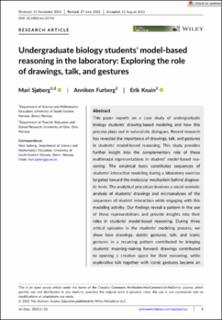| dc.contributor.author | Sjøberg, Mari Heum | |
| dc.contributor.author | Furberg, Anniken | |
| dc.contributor.author | Knain, Erik | |
| dc.date.accessioned | 2022-09-22T09:14:06Z | |
| dc.date.available | 2022-09-22T09:14:06Z | |
| dc.date.created | 2022-09-21T15:31:11Z | |
| dc.date.issued | 2022 | |
| dc.identifier.citation | Sjøberg, M., Furberg, A., & Knain, E. Undergraduate biology students' model-based reasoning in the laboratory: Exploring the role of drawings, talk, and gestures. Science Education, n/a(n/a). | en_US |
| dc.identifier.issn | 0036-8326 | |
| dc.identifier.uri | https://hdl.handle.net/11250/3020603 | |
| dc.description.abstract | This paper reports on a case study of undergraduate biology students' drawing-based modeling and how this process plays out in naturalistic dialogues. Recent research has revealed the importance of drawings, talk, and gestures in students' model-based reasoning. This study provides further insight into the complementary role of these multimodal representations in student' model-based reasoning. The empirical basis constitutes sequences of students' interactive modeling during a laboratory exercise targeted toward the molecular mechanism behind diagnostic tests. The analytical procedure involves a social-semiotic analysis of students' drawings and microanalyses of the sequences of student interaction while engaging with this modeling activity. Our findings reveal a pattern in the use of these representations and provide insights into their roles in students' model-based reasoning. During three critical episodes in the students' modeling process, we show how drawings, deictic gestures, talk, and iconic gestures in a recurring pattern contributed to bringing students' meaning-making forward: drawings contributed to opening a creative space for their reasoning, while explorative talk together with iconic gestures became an important resource in exploring the aspects that were not shown in the drawing. We also show how the different representations took on different semiotic loads depending on where in the modeling cycle they were. We show how certain semiotic choices in the first drawing seem to support the students' model-based reasoning. Representing gestures became particularly important when the students revised and extended their models. These findings are discussed in relation to the different affordances of the various modes of representation. | en_US |
| dc.language.iso | eng | en_US |
| dc.rights | Attribution-NonCommercial-NoDerivatives 4.0 Internasjonal | * |
| dc.rights.uri | http://creativecommons.org/licenses/by-nc-nd/4.0/deed.no | * |
| dc.title | Undergraduate biology students' model-based reasoning in the laboratory: Exploring the role of drawings, talk, and gestures | en_US |
| dc.type | Peer reviewed | en_US |
| dc.type | Journal article | en_US |
| dc.description.version | publishedVersion | en_US |
| dc.rights.holder | © 2022 The Authors. | en_US |
| dc.source.pagenumber | 1-25 | en_US |
| dc.source.volume | n/a | en_US |
| dc.source.journal | Science Education | en_US |
| dc.source.issue | n/a | en_US |
| dc.identifier.doi | https://doi.org/10.1002/sce.21765 | |
| dc.identifier.cristin | 2054042 | |
| cristin.ispublished | true | |
| cristin.fulltext | original | |
| cristin.qualitycode | 2 | |

